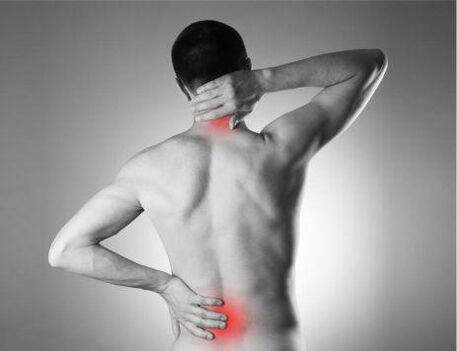In the case of osteochondrosis, the structure and function of the intervertebral discs, which give the spine flexibility and mobility.When the disease intensifies, irreversible changes occur in the vertebrae.

The causes of osteochondose are internally (endogenous) and external (exogenous).
Endogenous reasons are:
- Violation of the intrauterine development of the spine,
- Hereditary disposition and changes in age in the cartilage.
The most important exogenous cause of osteochondrosis is the improper distribution of the load on the spine, which leads to a change in the cartilage at the places of excess pressure.
Provoke the disease:
- Trauma of the spine,
- infections,
- weakened muscles,
- Bump and lateral S-shaped curvature of the spine,
- drug weights
- A long storage of an unpleasant attitude.
Osteochondrosis can not only develop in people with improper attitudes who deal with intellectual work, but also with physically well -trained people.
In addition to the mechanical reasons for the development of osteochondrosis, they also lead:
- metabolic disorders (mainly calcium and phosphorus),
- Lack of trace elements and vitamins (magnesium, manganese, zinc, vitamin D),
- The hereditary predisposition plays a rather big role.
When lifting weights, jumps, falls, static loads, micro -injuries of intervertebral discs appear.If this happens systematically, damaged intervertebral discs lose their elastic properties over time, flat and the distance between the vertebrae.And this means that the nerve roots that extend from the spinal cord hurt.At the same time, swelling appears in the neuro-vascular bundle clip, which leads to an even greater injury and increased pain.When the intervertebral disc has already started collapse, it stops, amortization, injured even more, and gradually the spine loses its flexibility.
The main sign for osteochondrosis is pain.Depending on where the damaged intervertebral discs are located, you can hurt: neck, shoulder, arm, back and even a chest.Sometimes a person believes that he has heart problems, but this actually hurts a nerve that is compressed by osteochondrosis.At the same time with pain, a person often feels about the stress and deafness of the muscles.When the blood vessels that feed the brain appear, headache, dizziness, noises in the ears, double eyes, nausea and vomiting appear.
You have to contact the neurologist with such symptoms.He examines the spine, checks how things are with brain circulation, and will prescribe radiography, computer or magnetic resonance imaging of the corresponding spine if necessary.
Treating osteochondrosis is a long process in which a person with great willpower and leisure is required.So far there are many methods to combat the disease: medicine, manual therapy, traction, massage and therapeutic gymnastics.
Tips for preventing radiculitis and osteochondrosis:
- Right procedure cranking of the cranking of the spine and strings in the Schuten School.
- Actively activate physical education so that you can form a sore muscles.
- Stop on a diet, consume products with a sufficient content of vitamins, calcium and magnesium (fish and other gifts of the sea, cabbage, spinach, beans, nuts, seeds, peas, gross bread and fresh milk).
- Fight for excess weight.
- When wearing weights, make a uniform load on both hands and wear backpacks instead of pockets.Just lift weights with legs, not with the spine.




















